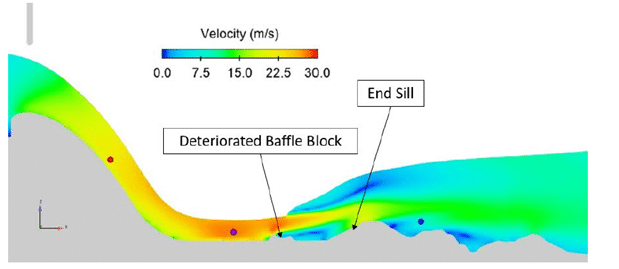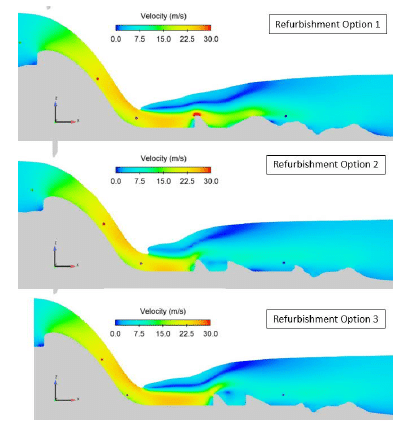Making The Mactaquac Dam New Again
FLOW-3D HYDRO computational fluid dynamics (CFD) software answers important questions about the future of New Brunswick’s historic Mactaquac Dam
This material was provided by Jason Shaw, Discipline Practice Lead – Hydrotechnical, Hatch Ltd.
Damming streams and rivers to generate electricity is nothing new. Beginning with Appleton, Wisconsin’s construction of the Vulcan Street Plant on the Fox River in 1882 — the world’s first hydroelectric power plant — dams now account for more than 70% of all renewable energy across the globe.
From the Grand Coulee and Chief Joseph dams in Washington State to the Mica and W.A.C. Bennett dams in British Columbia, the United States and Canada boast nearly 3,000 hydroelectric stations, powering more than 50 million homes and generating approximately 80% of the renewable energy consumed in North America.
Designing these massive objects has long been one of the most demanding of engineering activities. For starters, there are the structural concerns that come with pouring several million tons of concrete, followed by the need to manage many megawatts of electricity. But it’s determining the optimal way of passing water through, over, and around dams and spillways that has perhaps proven to be one of the most challenging design aspects of dam building, requiring costly physical models, lengthy analyses, and no small amount of educated guesswork.
Fortunately, hydraulic design has become much easier over recent decades thanks to the development of computational fluid dynamics (CFD) software. CFD is now an indispensable tool for dam designers and anyone who needs to understand what makes water and other fluids behave as they do, and how to effectively harness their immense power.
Straddling the St. John River
The Mactaquac Generating Station ranks high on the list of Canada’s essential dams. Located at the intersection of the Mactaquac River and the St. John River, this embankment dam sits twelve miles upstream from Fredericton, New Brunswick’s capital. Its six turbines generate 660 megawatts of power, making it the largest hydroelectric facility in the Canadian Maritime provinces. According to its operator, NB Power, the 55-meter tall, 518-meter long structure supplies approximately 12% of the province’s homes and businesses with electricity.
The Mactaquac Dam was completed in 1968 and intended to last 100 years. But as with any large-scale infrastructure project, unanticipated problems can sometimes occur, some of which might fail to emerge for years or even decades after the foundation is laid. Such is the case with the Mactaquac Dam, where an adverse chemical phenomenon known as alkali-aggregate reaction (AAR) caused the concrete to swell and crack, resulting in significant and ongoing annual maintenance and repair costs.
Granted, CFD analysis would neither have predicted nor prevented this particular problem, but it can help to answer the question of how to refurbish the structure. Is it enough to simply replace the faulty concrete, or will a significant redesign be necessary? This is where Jason Shaw and his team at Hatch comes into the picture.
Building relationships
A Project Manager and Hydraulic Engineer at Hatch Inc., Shaw and the other 9,000 professionals at the Mississauga, Ontario-based consulting firm have extensive experience in a range of industries, among them civil engineering, mining, oil and gas, and all manner of infrastructure design and development, power generation facilities included.
They’ve also had a long-term relationship with NB Power. “In 2004, Hatch acquired Acres International, an engineering consultancy with expertise in dams and hydropower,” said Shaw. “They were the original designer of Mactaquac and have since become part of our energy group”.
As such, we’ve had a longstanding relationship with NB Power, and we continue to do work for them, not only Mactaquac life-extension, but other facilities as well.”
Shaw explained that alkali-aggregate reaction is very difficult to manage. In the Mactaquac Dam’s case, high amounts of silica in the locally-quarried greywacke—a type of sandstone used to make the concrete—caused a chemical reaction between it and the alkaline limestone found in cement. The result is a viscous gel that, in the presence of water, expands over time, leading to spalling, cracking, and rebar exposure.
“One area of concern is the spillway, where the baffle blocks and end sill have seen significant deterioration,” said Shaw. “But it’s really everything about the dam that’s in jeopardy. Because the concrete is squeezing on the gate guides, for example, you get to the point where the spillway gates are at risk of binding. And in the powerhouse, it’s pushing on the concrete that holds the power generation units, causing them to shift location and become ‘out-of-round’. The consequences are gradual but distortions are inevitable, leading to the requirement for a complex structural remediation.”
To avoid this, NB Power commissioned Hatch to study the problem and provide options on how to move forward. Since AAR issues were discovered in the 1980s, the Hatch team has installed sensors throughout the structure to monitor structural movement and concrete performance. They continue to analyze the ongoing alkali-aggregate reaction in an effort to understand how the concrete is deteriorating and ways extend the life of the project. NB Power and Hatch even pioneered cutting small, strategic spaces and gaps in the dam using diamond wire saws to relieve internal stresses and manage deformations.
Saving the spillway
Over the course of the project, NB Power determined their best option was to refurbish the dam by repairing and improving the damaged portions. A major part of this plan included a hydraulic analysis to determine the best approach. This helped answer questions about whether the operating conditions of the existing structure may have accelerated erosion of the spillway, and if any modifications could be made to reduce this risk. Much of that analysis was based on Hatch’s extensive use of CFD software to determine which parts of the spillway structures need replacing and what designs would provide the best results.
That software comes from Flow Science Inc. of Santa Fe, New Mexico, developers of FLOW-3D HYDRO. “We’ve had a relationship with Flow Science for close to 30 years,” said Shaw. “In fact, I’d say we were probably one of the early adopters, although now practically everyone in the industry is using it and it’s far from novel to use CFD on projects like this.”
Prior to CFD, the only alternative would have been to perform the analysis using a scaled physical model. Shaw noted that this is not only time-consuming, but if multiple iterations are needed, it may promote schedule delays and escalate project development costs. Additional factors related to the scaling of the physical model can also lead to questionable conclusions. CFD, on the other hand, allows engineers to iterate at scale as much as necessary. Various scenarios are easily tested, solutions applied, and the optimal design quickly determined. Physical models are still used, but as a means of validation rather than experimentation.
“CFD fills a crucial gap,” said Shaw. “It allows designers to examine a range of different scenarios that would otherwise be very costly to replicate. This allows you to fine-tune a design and, when you’re ready, check it against the physical model—if they agree, it eliminates any question marks.”
Moving downstream
This was exactly the case with the Mactaquac project, where the first phase of the project was validating the CFD model against measurements from a past physical modeling study of the site. This critical stage of the study allowed the engineers to quantify uncertainty and build confidence in the results of the CFD simulations. Shaw and his team were able to compare these physical model results against the newly-created 3D CFD model of the dam and its surrounding area. They soon found reasonable correlation between the two, providing them with a high degree of confidence that they were on the right track and that their CFD analyses were correct.
A 3D model is only as good as its calibration and validation, he said. If you can’t provide that, then you don’t know where you stand, regardless of the approach. Despite the need for this critical step, however, CFD is a necessary part of the analysis train, if you will. It represents a more precise and more accurate way of analyzing a complex problem. These studies have served as a basis for making decisions about the dam’s future rehabilitation.
After successful validation of the CFD model, the next phase of the study used FLOW-3D HYDRO to evaluate the existing conditions in the deteriorated spillway. Engineers compared estimates of water depths, jump containment, velocities and pressures on the aprons related to energy dissipation, and erosion and cavitation potential for the concrete structures as well as the tailrace areas downstream from each structure. CFD simulations illustrated hydraulic performance for each of these variables, allowing the team to accurately evaluate the three proposed refurbishment options. Ultimately, the CFD model results led the design team to recommend restoration of the original spillway dimensions, adding two new baffle blocks, and modifying the spillway end sill. The CFD results also raised concerns that cavitation may have played a role in the concrete erosion, which led to further recommendations for modified baffle block designs.
A great deal of work remains before the Mactaquac Generating Station is restored. FLOW-3D HYDRO has allowed Hatch to identify the best approach moving forward, giving them a solid footing to plan and design future improvements and refurbishment. It allowed them to pinpoint the most effective way to improve hydraulic performance and reduce the risk of future erosion in the most efficient and cost-effective possible way.
“The intent here is to move forward with project development using CFD analyses and continue to sharpen the pencil,” said Shaw. I’m very confident that we will derive design solutions that will ensure hydraulic spill performance at Mactaquac which will meet the objective of ensuring a safe design.”









